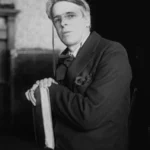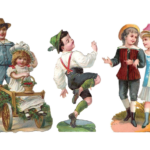Summary of ‘A Dialogue of Self and Soul’ by W.B. Yeats

W.B. Yeats’ “A Dialogue of Self and Soul” is a philosophical poem. This poem was first published in 1933 in Yeats’ poetry collection “The Winding Stair and Other Poems.”
Introduction to the poem:
The poem A Dialogue of Self and Soul – by W.B. Yeats is written as a conversation between two voices inside a person. It can be summarised in the following manner:
-
Soul wants to leave the world, avoid pain, and move towards spiritual peace. It believes true happiness comes from leaving behind human desires and living a quiet, pure life.
-
Self, on the other hand, wants to live life fully—to experience love, mistakes, suffering, and joy. It believes that every moment of life, even the painful ones, is valuable and teaches us something important.
A brief introduction of W.B. Yeats:

William Butler Yeats (1865–1939) was a famous Irish poet and playwright. He was born in Dublin but spent much of his childhood in County Sligo, which inspired many of his poems. Yeats loved Irish myths and folk stories and wanted to bring Irish culture and literature to life.
He co-founded the Abbey Theatre to promote Irish drama and became a prominent voice in Ireland’s fight for cultural and political independence. Yeats’ poetry changed over time—from dreamy, romantic poems to deeper, modern poems about life, politics, aging, and spirituality.
In 1923, he won the Nobel Prize in Literature for his beautiful and meaningful poetry. Some of his best-known poems are “The Lake Isle of Innisfree,” “The Second Coming,” “Sailing to Byzantium,” and “Easter 1916.”
Yeats was also involved in politics, serving as a senator in the Irish Free State. He is remembered as one of the greatest poets of the 20th century who connected Ireland’s traditions with modern ideas.
Summary of the Poem: ‘A Dialogue of Self and Soul’

W.B. Yeats’ “A Dialogue of Self and Soul” is a philosophical poem. This poem was first published in 1933 in Yeats’ poetry collection “The Winding Stair and Other Poems.” This poem illustrates the tension between worldly experience and spiritual detachment as experienced by humans. In the poem, Yeats showcases a conversation between two opposing voices—the Self, representing passion, physical life, and human desire. The Soul represents asceticism, spiritual purity, and transcendence—the poem debates the meaning and purpose of human existence. The Soul urges the Self to renounce worldly attachments and seek salvation through spiritual ascent, symbolized by the “winding ancient stair.”
In contrast, the Self embraces the fullness of life, with all its suffering, mistakes, and joys, arguing that true wisdom lies in experiencing existence completely rather than escaping it. The poem concludes with an affirmation of reincarnation and cyclical time, as the Self declares willingness to live life again and again. Ultimately, Yeats rejects strict spiritual withdrawal, suggesting that embracing human experience brings one closer to spiritual fulfillment.
Part I: Dialogue between Soul and Self (six paragraphs)
Paragraph 1 (Soul speaks)
The Soul calls the Self to climb a “winding ancient stair,”. It asks to fix the mind on the steep ascent to a spiritual realm (the hidden pole), where thought ends and the soul resides. It urges detachment from worldly distractions and pursuits
Paragraph 2 (Self responds)
The Self answers with an image of a consecrated blade—a Japanese sword wrapped in embroidered silk. The sword is sharp and pristine; the faded embroidery (court-lady’s dress) still protects and adorns, symbolizing the Self’s attachment to both martial valor and aesthetic beauty in earthly life.
Sato’s sword:
-
The poem mentions “That flowering, silken, old embroidery, torn / From some court-lady’s dress and round / The wooden scabbard bound and wound, / Can, tattered, still protect, faded adorn / A noble blade, the great-grandfather’s sword.”
-
Yeats imagines this sword as having been given by Sato, a symbolic Eastern figure representing honor, heritage, and the enduring value of worldly life and action.
-
The sword itself symbolizes earthly courage, history, and attachment to the human experience, standing in contrast to the Soul’s call for detachment and spiritual escape.
So, Sato is not a real person from Yeats’ life but a symbolic character, embodying Eastern chivalry and warrior tradition, reinforcing the Self’s argument for embracing life rather than abandoning it.
Paragraph 3 (Soul again)
The Soul questions why the Self still cherishes such symbols of love and war past its prime. It urges the Self to scorn earthbound imagination and transient intellect, offering deliverance from the “crime of death and birth” through spiritual ascent.
Paragraph 4 (Self replies)
The Self explains the sword was crafted centuries ago and remains a claim to life and action. With heart‑purple embroidery, it sets that symbol “against the tower” (night), asserting a warrior’s right to live again, even commit the “crime” of attachment to worldly existence
Paragraph 5 (Soul speaks again)
The Soul describes spiritual overflow falling into the mind’s basin, causing intellectual silence: no distinction between knower and known. Only the dead can be forgiven, it says—so when it contemplates this, its tongue becomes a stone
Paragraph 6 (Self begins monologue)
The Self launches into its perspective: a living man may be imperfect, drinking life from impure ditches, but this doesn’t matter. It is willing to live life again—re-living struggles and humiliations of childhood, growing up, clumsiness—instead of escaping into detached purity.
Part II: Self’s extended monologue (three paragraphs)
Paragraph 7
The Self describes the pains of growing up: shame in boyhood, awkward adolescence, and the struggles of adulthood. It confronts a harmful image cast by malicious eyes and wonders what good escape can offer if honor is at stake in “wintry blast” (harsh conditions)
Paragraph 8
It states willingness to live life over again—even if it means falling into the “frog-spawn” of a blind man’s ditch or enduring folly in loving someone not kindred in soul. Symbolically, these choices include painful love and egoistic mistakes
Paragraph 9
Finally, the Self asserts determination to trace every event back to its origin in thought and action, forgive itself, and cast out remorse. This surrender brings “sweetness,” leading to laughter, songs, and a profound blessedness: everything becomes sacred, and life is affirmed completely
Importance of the Poem: ‘A Dialogue of Self and Soul’
-
Spiritual and Philosophical Depth – The poem captures Yeats’ mature philosophical outlook, exploring the universal conflict between worldly engagement and spiritual transcendence (Soul).
-
Shift from Earlier Beliefs – Earlier in his career, Yeats leaned toward mysticism and ascetic spiritual ideals. This poem marks a shift toward embracing life’s experiences, with its suffering and imperfection, which reflects his personal growth.
-
Modernist Themes – The poem reflects Modernist ideas of questioning traditional religion, blending Western and Eastern philosophies (Christian salvation vs. reincarnation and karma), making it significant in 20th-century literature.
-
Symbol of Reconciliation – The dialogue comes to an end with harmony between Self and Soul, suggesting that true spirituality comes from living fully, not rejecting the physical world—a concept that reshaped later philosophical poetry.
-
Part of Yeats’ Later Works – Written during Yeats’ later years, it is central to understanding his “Winding Stair” phase, where he reflected on aging, mortality, and spiritual wisdom.
Themes: ‘A Dialogue of Self and Soul’

W.B. Yeats’ “A Dialogue of Self and Soul” is a philosophical poem. This poem was first published in 1933 in Yeats’ poetry collection “The Winding Stair and Other Poems.”
-
Conflict between Body and Spirit: The central dialogue shows the tension between worldly life and spiritual salvation.
-
Acceptance of Life: Yeats emphasizes the value of living fully and experiencing human passions over renouncing them.
-
Mortality and Rebirth: The poem reflects on death but frames it as part of a natural cycle, not as something to be escaped.
-
Wisdom through Suffering: Self argues that even pain and failure are necessary for growth and understanding.
-
Eastern Philosophy Influence: Concepts like reincarnation and karma echo Buddhist and Hindu philosophies, which Yeats studied.
Style: ‘A Dialogue of Self and Soul’
-
Dramatic Dialogue: Written as a debate between two abstract entities (Self and Soul).
-
Symbolism: Uses images like the “winding ancient stair” (representing spiritual ascent), and references to swords and scabbards (symbolizing action and renunciation).
-
Philosophical Tone: Reflective, meditative, exploring existential questions.
-
Modernist Elements: Challenges traditional Christian ideas of salvation, incorporating Eastern mysticism and cyclical time.

Conclusion:
-
Yeats’ “A Dialogue of Self and Soul” explores the debate between worldly experience and spiritual renunciation.
-
The poem ultimately affirms living fully, embracing the cycle of life and rebirth, finding divinity not in withdrawal but in passionate human existence.
FAQs on “A Dialogue of Self and Soul” by W.B. Yeats
1. What is the poem “A Dialogue of Self and Soul” about?
It is a philosophical poem where two voices—Self (which represents human desires and the physical world) and Soul (which represents the spiritual, eternal self)—have a debate. The Soul wants peace through spiritual detachment, while the Self wants to live fully, embracing life’s pain and joy.
2. When was the poem written and published?
It was written in the early 1930s and published in Yeats’s 1933 poetry collection titled The Winding Stair and Other Poems.
3. What is the central conflict in the poem?
The main conflict is between the desire to escape worldly life and reach spiritual peace (Soul) and the desire to embrace the human experience, with all its imperfections (Self).
4. Who wins in the end—Self or Soul?
Self wins in the end. While the Soul promotes detachment and spiritual stillness, the Self boldly chooses to return to life, accepting its struggles and joys as meaningful.
5. What does the sword given by Sato symbolize?
The sword represents honor, tradition, courage, and active engagement with life. It’s a symbol of how even old, worn things can still carry power and beauty—just like human life, with all its flaws.
6. Is the poem autobiographical?
Yes, to some extent. Yeats was aging and had health problems. His doctor had advised him to rest and stop writing. But through this poem, Yeats affirms his belief in continuing to live fully and write passionately.
7. What is the theme of the poem?
Answer given above
8. What is the tone of the poem?
The tone is philosophical, reflective, and defiant. It shifts from calm and spiritual (Soul) to passionate and bold (Self).
9. What is the poetic style of Yeats in this poem?
The poem is written in ottava rima (eight-line stanzas with a specific rhyme scheme: ABABABCC), a form Yeats often used for serious, reflective topics.
10. Why is “A Dialogue of Self and Soul” considered a modernist poem?
Because it explores inner conflict, spiritual doubt, and personal meaning—all major concerns of Modernist literature. Also, Yeats mixes Eastern and Western symbols, personal philosophy, and myth.
Read more:
- Dream Children: A Reverie by Charles Lamb
- “The Terror” – Guy de Maupassant
- “Nectar in a Sieve” by Kamala Markandaya
- Types of Prose and Prose Styles
- Historical Novel: Overview, Origin, Development, and Major Writers

